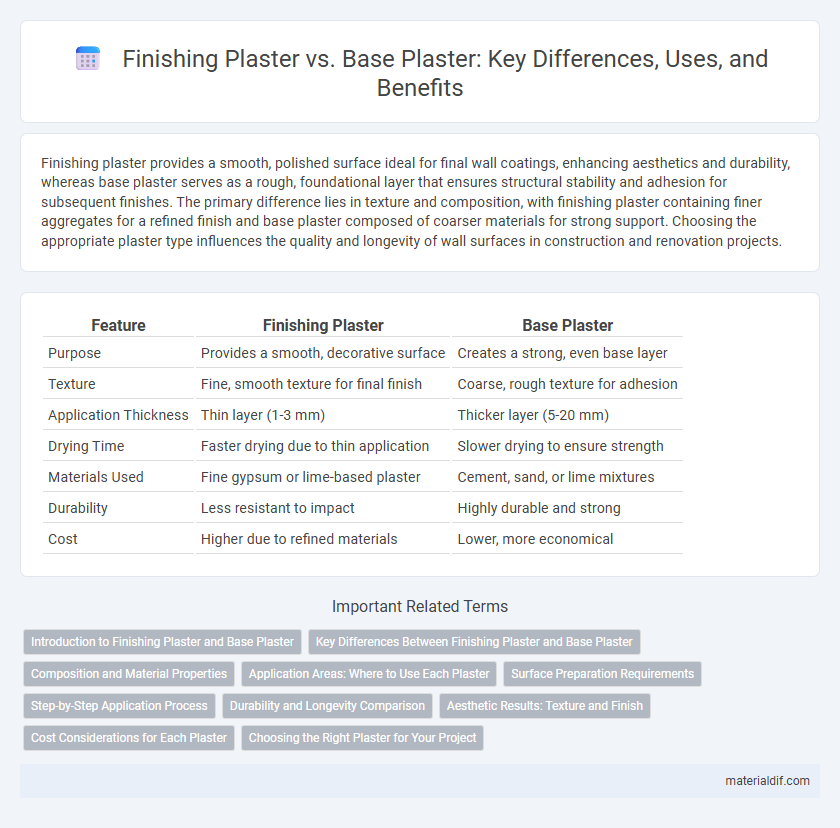Finishing plaster provides a smooth, polished surface ideal for final wall coatings, enhancing aesthetics and durability, whereas base plaster serves as a rough, foundational layer that ensures structural stability and adhesion for subsequent finishes. The primary difference lies in texture and composition, with finishing plaster containing finer aggregates for a refined finish and base plaster composed of coarser materials for strong support. Choosing the appropriate plaster type influences the quality and longevity of wall surfaces in construction and renovation projects.
Table of Comparison
| Feature | Finishing Plaster | Base Plaster |
|---|---|---|
| Purpose | Provides a smooth, decorative surface | Creates a strong, even base layer |
| Texture | Fine, smooth texture for final finish | Coarse, rough texture for adhesion |
| Application Thickness | Thin layer (1-3 mm) | Thicker layer (5-20 mm) |
| Drying Time | Faster drying due to thin application | Slower drying to ensure strength |
| Materials Used | Fine gypsum or lime-based plaster | Cement, sand, or lime mixtures |
| Durability | Less resistant to impact | Highly durable and strong |
| Cost | Higher due to refined materials | Lower, more economical |
Introduction to Finishing Plaster and Base Plaster
Finishing plaster is a fine, smooth plaster applied in thin layers to create a polished surface ready for painting or wallpapering, enhancing interior aesthetics. Base plaster, typically coarser and thicker, provides a stable, strong foundation by adhering to walls and ceilings, ensuring durability and structural integrity. Both types are essential in construction, with base plaster supporting the building framework and finishing plaster delivering the final decorative finish.
Key Differences Between Finishing Plaster and Base Plaster
Finishing plaster is formulated for smooth, polished surfaces ideal for decorating, while base plaster provides a rough, sturdy layer that adheres well to structural substrates. Finishing plaster typically contains finer aggregates and sets faster, ensuring a sleek finish, whereas base plaster has coarser materials for enhanced durability and bonding. The key differences lie in texture, composition, and purpose: finishing plaster enhances aesthetics, and base plaster ensures foundational strength.
Composition and Material Properties
Finishing plaster typically consists of fine aggregates, such as hydrated lime or gypsum, combined with additives that enhance smoothness, adhesion, and workability, making it ideal for creating a polished surface. Base plaster contains coarser aggregates like sand and cement, providing structural strength and durability to support the finishing layer. The water absorption rate is lower in finishing plaster due to its fine composition, while base plaster exhibits higher compressive strength and resistance to cracking because of its robust material properties.
Application Areas: Where to Use Each Plaster
Finishing plaster is primarily used for interior walls and ceilings where smooth, paint-ready surfaces are required, such as living rooms, bedrooms, and offices. Base plaster serves as an undercoat applied to rough masonry or concrete surfaces, providing a stable, even foundation for finishing plaster in both interior and exterior applications. Each plaster type is chosen to optimize durability and aesthetics according to specific construction needs and environmental exposure.
Surface Preparation Requirements
Finishing plaster requires a thoroughly clean, dust-free, and slightly dampened base surface to ensure proper adhesion and a smooth, flawless finish. Base plaster demands a rougher, keyed substrate, often applied directly onto masonry or lath, to provide a solid foundation for subsequent plaster layers. Proper surface preparation enhances durability and prevents cracking or peeling during the plaster curing process.
Step-by-Step Application Process
Finishing plaster requires a smooth, thin application completed in multiple fine coats to achieve a polished surface, often involving sanding between layers for optimal texture. Base plaster is applied in thicker layers to build up wall strength and stability, starting with a scratch coat followed by a brown coat for structural foundation. Precise timing and curing between each step ensure adhesion and durability in both finishing and base plaster applications.
Durability and Longevity Comparison
Finishing plaster typically offers a smoother, more refined surface but is less durable and more prone to cracking compared to base plaster, which is designed for strength and structural support. Base plaster often contains coarser aggregates and binding agents that enhance its lifespan and resistance to impacts. The longevity of base plaster makes it essential for foundational layers, while finishing plaster primarily contributes to aesthetics and final surface texture.
Aesthetic Results: Texture and Finish
Finishing plaster provides a smooth, fine texture ideal for achieving polished, aesthetically pleasing surfaces, enhancing interior design with its even, sleek finish. Base plaster offers a rougher texture intended for structural support, serving as a strong foundation layer that improves adhesion for finishing plaster. The choice between base and finishing plaster directly influences the final wall appearance, with finishing plaster delivering superior visual refinement.
Cost Considerations for Each Plaster
Finishing plaster typically incurs higher costs due to its finer texture and greater labor intensity required for smooth, detailed surfaces, making it ideal for visible walls and ceilings. Base plaster is more cost-effective, offering a robust underlayer that supports finishing coats while being less expensive in materials and application. Choosing between the two depends on budget constraints and the desired aesthetic finish in construction projects.
Choosing the Right Plaster for Your Project
Selecting the right plaster for your project hinges on understanding the functions of finishing plaster and base plaster. Base plaster provides a durable, rough surface that enhances adhesion for subsequent layers and is ideal for structural applications, while finishing plaster offers a smooth, refined texture perfect for aesthetic surfaces and detailed decoration. Considering factors like surface type, desired finish, and project environment ensures optimal plaster performance and longevity.
Finishing Plaster vs Base Plaster Infographic

 materialdif.com
materialdif.com